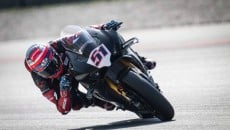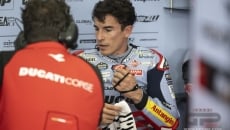Preparations are underway for the first Grand Prix of the year (at least for MotoGP). In just over a week the teams will leave for Jerez and from there onwards it will be a succession of races that will leave you breathless. A big effort for the riders but not only. At Clermont-Ferrand they have been planning for this season for a long time: tight deadlines, date changes, are some of the problems that Michelin has had to face and solve.
"2020 had started well with the tests in Sepang and Qatar, we had brought a rear tyre with a new structure and the times had been good, it was better in everything than the one of the previous year - remembers Piero Taramasso, track racing manager for the French tyre company - There had been teams that had immediately found the right setup and whose riders had adapted well, others that still had to work, like Ducati and Honda, but I think that in this period of inactivity they were able to analyse all the data and better understand how to use this tyre. I expect a good start to the championship. "
What has Michelin been working on in recent months?
“We continued to work, to analyse the data in more detail, having time. Then we prepared three different options pending the calendar and when we had it, we were able to focus on the circuits and the dates of the races. "
What is the biggest unknown factor?
"The thing that immediately catches the eye is Jerez, we expected to race in May instead we will do it in July, so with much higher temperature, we could have 10 or even 15 degrees more than usual, there are many. It is certainly the biggest change. "
How did you prepare for that?
“With the simulation software and then looking at the data of the past seasons. In the end we decided to eliminate the initially foreseen soft rubber and to increase all the options by one step as regards hardness, adding a rubber that gives us the certainty of working well even in extremely hot conditions ".
Tests are scheduled at Jerez on Wednesday before the race, would there still be time to intervene if there were problems?
“If they were big, we might be able to do it, but I don't think there will be any need. It is true that we never raced there in the summer, but we have the data of private tests and the experience in the Spanish SBK championship, it is a track that we know quite well. The tyres that the riders will have in those tests will be exactly the same as those for the two Grands Prix. In all double races the tyres will always be the same".
Besides Jerez, are there any other important changes?
“The other Grands Prix were confirmed on similar dates as usual, or in any case without large changes in temperature. In Le Mans in October it should be colder than the initial date, but already for that appointment we had chosen compounds for extreme cold, it will be enough even in autumn because they can also work with 10° of temperature on the asphalt ".
Even in Valencia, in mid-November, could there be the same problem?
“We have already had experience in recent years with cold and rain, even there we will bring tyres for low temperatures. In general, however, there will be no revolutions compared to what was planned at the beginning of the year, only a few tweaks. Next week we will communicate the list of tyres for all the Grands Prix. We also had the opportunity in last week's private tests to try the new asphalt in Misano and now we are more serene ".
Have you already prepared all the necessary tyres?
“It was a big job, it takes a week to start up the machines, get back on track, and at the same time order the necessary compounds and materials. Then it takes two or three weeks to produce all the tyres needed for a Grand Prix. We are not talking about series production machines; the times are longer. At the moment we already have the tyres ready for the first 3 circuits, then for 5 races, and gradually we will continue with the production. We are respecting the schedule, Dorna gave us all the information on time. "
Will your track work be so different?
“Basically, it all remains the same, our technicians will be in the pits respecting all the safety measures. The development manager and I will try to move as little as possible while before we jumped from one side to the other. We will use masks and visors to talk to the riders. The first Grand Prix will be a run-in, I also think of the guys who fit the tyres, they too will have to wear masks, in the heat it will not be pleasant but certainly necessary ".
There are no tests scheduled this year, is it a problem for tyre development?
"Yes, because in our initial program we had planned to continue testing the new front tyre, which we had already brought to the Misano and Brno tests last year. If the results had been positive, we would have liked to introduce it in 2021 but now everything will be postponed by a year, so possibly it will debut in the race in 2022 ".
How will the double race on the same circuit affect the drivers' adaptation to the new tyres?
"The new rear tyre has a lot of grip, so you have to work on the balance and setting of the bike, also the rider must adapt both in braking and acceleration. With two races there will be more time to get it right and I think that in the second race, where everyone will come prepared, we will see a lot more of a brawl. I would not be surprised to see 15 riders in one second in qualifying or arrive at a photo finish with 3 or 4 bikes, I think it will be very spectacular and there will be more varied podiums than usual. The riders will be able to better exploit the potential of the bikes and tyres and the track conditions will also be better. "
What does a championship so compressed in time imply for your work?
"The problem of having many races one after another is logistics. For each race weekend we bring 1,200 tyres between slick and rain, but not all of them are used, usually between 500 and 550, and 2,400 tyres cannot be brought altogether for the double race. Our strategy is to bring 1,200 and then, on Sunday evening, based on the quantity used, decide what is needed for the next Grand Prix. So, we will produce tyres at the last minute and it is a new way of working. It is necessary to calculate well the times, to bring tyres from our factory to Jerez takes 3 days, to Brno 2 and a half days, there is no room for error. Even for the staff it will be a big effort, it will be like racing a triple-header every month, but thanks to our passion we will do it. "









